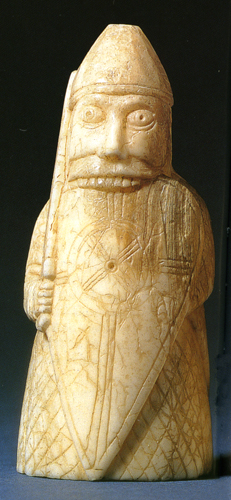Why You Should Never Laugh at a Berserker
 The definitive short guide to our Uig Chessmen, found in Ardroil in 1831, is The Lewis Chessmen, by James Robinson of the British Museum, which addresses aspects of their discovery, design and likely provenance, and also the history of chess. Of our little family of courtly Vikings, the berserkers are the most intriguing. From the book:
The definitive short guide to our Uig Chessmen, found in Ardroil in 1831, is The Lewis Chessmen, by James Robinson of the British Museum, which addresses aspects of their discovery, design and likely provenance, and also the history of chess. Of our little family of courtly Vikings, the berserkers are the most intriguing. From the book:
There are twelve warders, or rooks, all of whom defend themselves with shields decorated in a similar fashion to the knights’. They are represented as foot soldiers and each carries a sword. All wear helmets, apart from one who, along with three others, bites the top of his shield in the most disturbing manner. It was [Sir Frederic] Madden’s expert knowledge of Norse sagas which solved for him the meaning of this puzzling gesture. He published his finding in his 1832 article about the chessmen for Archaeologia, quoting the Heimskringla of Snorri Sturluson (c1179-1241):
The soldiers of Odin went forth to combat without armour, raging like dogs or wolves, biting their shields, and in strength equal to furious bulls or bears. Their enemies lay prostrate at their feet: neither fire not weapons harmed them; this frenzy was known as Berserksgangr.
‘Berserker’, which gave us the modern word ‘berserk’ to describe a violent frenzy, may have originally meant ‘bare-shirt’ (ie, shirtless) or ‘bear-shirt’. Both terms express wildness. The Lewis berserkers are protected by armour, and, although one lacks a helmet, it is the specific act of biting the shield that communicates their frenzy. […]
The Berserkers, although irresistibly comic to a modern audience, were probably not conceived as figures of fun, but as serious fighting machines who embodied a heroic ideal. They appear in a literary context, for instance in the Heimskringla, as an expression of poetic nostalgia for a lost, golden age. Rather as with characters from the pagan Classical past, the heroes of Norse mythology may have been used as sumbols for the coming of Christianity.
[Similarly] the queens, often viewed by a modern audience as looking bored or worried, are rather more likely to be communicating contemplation, repose and possibly wisdom.
© British Museum

